Figure 5.
Motor cortex excitability. (A and B) The tongue motor cortex is more excitable during resting state within the experimental speech trial (task) compared to resting state during the recording of the input-output curve (no task). Stimulation intensity was 120% of the individual motor threshold in both conditions. Depicted are MEP amplitudes averaged across all subjects. Grand average MEP amplitudes for fluent speakers and adults who stutter are comparable in magnitude within conditions and within hemispheres. (C) Motor thresholds are plotted as percentage of the maximum stimulator output. Adults who stutter exhibit higher motor thresholds than fluent speakers. (D and E) To exhaustively test whether speaking with the mouthpiece affects excitability of the tongue motor cortex, we compared grand average amplitudes of the first 20 MEPs with the last 20 MEPs acquired in the transition phase after the second go-signal. The first MEP amplitudes were larger in magnitude compared to the last MEP amplitudes. When separated for hemisphere and group, only left hemisphere stimulation evoked larger MEP amplitudes in fluent speakers than in adults who stutter. (F) Shown are group mean MEP amplitudes of the input-output curve averaged over both hemispheres. MEP amplitudes increase with rising stimulus intensity. The contralateral projection of the tongue (solid line) shows a slightly stronger attenuation compared to the ipsilateral projection (dashed line). Error bars indicate the standard error of mean. Asterisks indicate significance levels: *P < 0.05, ***P < 0.001.

